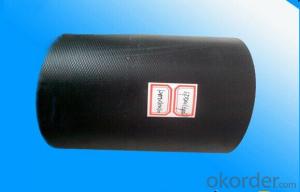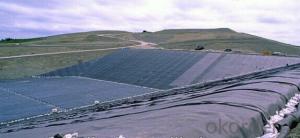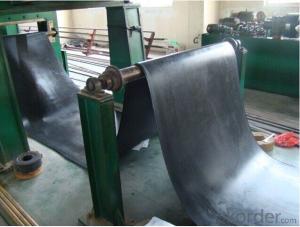EPDM Coiled Rubber Waterproof Membrane Manufacturer
- Loading Port:
- Qingdao
- Payment Terms:
- TT OR LC
- Min Order Qty:
- 2000 m²
- Supply Capability:
- 10000 m²/month
OKorder Service Pledge
OKorder Financial Service
You Might Also Like
EPDM Coiled Rubber Waterproof Membrane
1. Introduction
This waterproof coiled material is of high elasticity with best performance among high polymer waterproof coiled material in the world, it is also the most typical one in the world.
Waterproof coiled material made of ternary ethylene-pro-pylene rubber of DHK is produced with the use of the most advanced continuous extrusion and vulcanization technology and related equipments which are specially designed for production of such product. It is good in compactness, without bubble and performance difference in length and breadth, performances reach or exceed the demands of GB 18173.1-2000 standard.
2. Characteristics
1.Excellent weather resistance, durability and size stability
2.Good adaptability to high and low temperature, UV resistant and anti-corrosion
3. High tensile strength and good elongation, accommodating to structure movement.
4. Easy installation, solid joint, and no environmental pollution
5. Good rooting penetration resistance.
6. Service life up to 50 years
3. Specification:
Type | EPDM Waterproof Membrane | |||
Material | EPDM Rubber | |||
Thickness | 1.0mm | 1.2mm | 1.5mm | 2.0mm |
Size | 1.2m(width) * 20m(length)/roll | |||
Type | Vulcanized | |||
Pattern | Non-reinforced(homogeneous) | |||
Packing | 24sqm--80sqm/roll, with plastic bag | |||
Color | Black | |||
Application | Roofs, basement, pond, Lake, steel structure roof, swimming pool, underground, tunnel, etc | |||
5. Some photos:
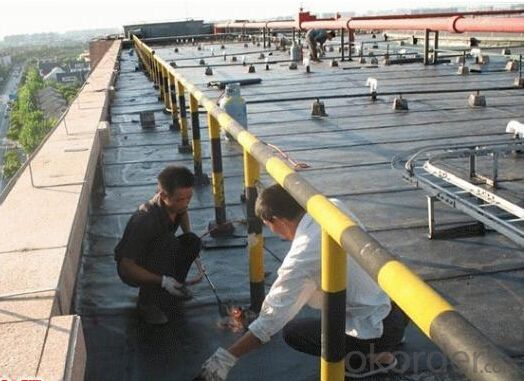
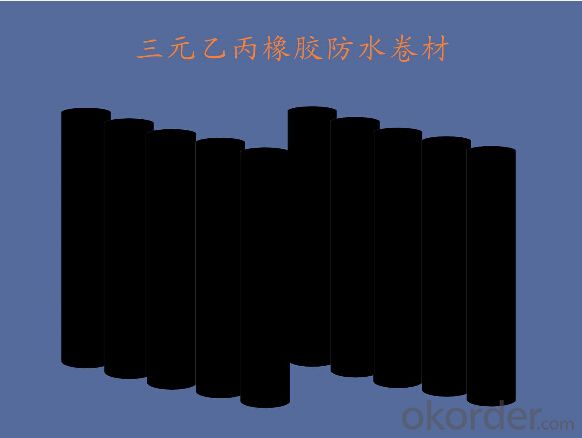
- Q:Can a waterproofing membrane be used for stadiums or sports fields?
- Stadiums or sports fields can benefit from the use of a waterproofing membrane. This type of membrane is commonly employed in construction projects to safeguard the underlying structure from moisture damage and prevent water infiltration. Given that stadiums and sports fields are constantly exposed to various elements, such as rain, snow, and irrigation, a waterproofing membrane serves as an effective solution to protect the foundation and other structural elements from water damage. Additionally, it maintains the integrity and durability of the playing surface, preventing issues like unevenness, soft spots, or slippery conditions caused by water seepage. In conclusion, the utilization of a waterproofing membrane is instrumental in enhancing the performance and longevity of stadiums and sports fields, as it acts as a moisture barrier.
- Q:How does a waterproofing membrane handle movement joints or cracks?
- A waterproofing membrane is designed to handle movement joints or cracks by providing a flexible and stretchable barrier that can accommodate the shifting or settling of a structure. When there are movement joints or cracks present, the membrane is applied in a way that creates a continuous and seamless layer over the surface. The flexibility of the waterproofing membrane allows it to move and adapt to changes in the structure, such as expansion or contraction, without compromising its integrity. This is especially important in areas where there is significant movement or where cracks are prone to develop, such as in concrete slabs or foundations. In the case of movement joints, the membrane is typically terminated or split at the joint to allow for movement without creating stress or tension on the membrane. This ensures that any movement or shifting of the structure does not cause the membrane to tear or fail. For cracks, the waterproofing membrane is applied directly over the surface, bridging the gap and sealing it off from water infiltration. The flexible nature of the membrane allows it to stretch and conform to the shape of the crack, effectively sealing it and preventing further water damage. Overall, a waterproofing membrane is designed to handle movement joints or cracks by providing a durable and flexible barrier that can accommodate structural movements and prevent water penetration. This helps to maintain the integrity of the structure and protect it from water damage.
- Q:Does a waterproofing membrane provide any insulation benefits?
- A waterproofing membrane does not offer any insulation benefits, unlike insulation which is specifically designed to regulate temperature and prevent heat transfer. The primary function of a waterproofing membrane is to safeguard the underlying structure from water damage by creating a barrier that prevents water from penetrating through the surface. This barrier acts as a protective shield, maintaining the structure's integrity and keeping water out. On the other hand, insulation materials are installed within the walls, floors, or roofs of a building to provide thermal resistance and enhance energy efficiency. Insulation works by reducing the transfer of heat between the interior and exterior of the building, thus creating a comfortable indoor environment. While both waterproofing and insulation contribute to the overall performance and durability of a building, they serve distinct purposes. Waterproofing focuses solely on keeping water out, whereas insulation focuses on temperature regulation. To achieve optimal results, it is crucial to utilize appropriate waterproofing and insulation materials in their respective areas.
- Q:Can a waterproofing membrane be used in conjunction with fire protection systems?
- Yes, a waterproofing membrane can be used in conjunction with fire protection systems. While the primary function of a waterproofing membrane is to prevent water penetration, it can also act as a barrier to protect against fire. Some waterproofing membranes have fire-resistant properties, allowing them to withstand high temperatures and prevent the spread of fire. However, it is essential to ensure that the specific waterproofing membrane chosen is compatible and approved for use with the fire protection system in question.
- Q:Can a waterproofing membrane be used for sealing pipe penetrations?
- Sealing pipe penetrations can be achieved with the use of a waterproofing membrane. These membranes are specifically designed to form a barrier against water intrusion and can effectively seal different types of penetrations, including pipes. In construction projects, they are widely utilized to prevent water leaks and potential damage. By applying the waterproofing membrane around the pipe penetration, a watertight seal is created, preventing the entry or escape of water through the opening. This action helps maintain the building envelope's integrity and safeguards against potential water-related problems like leaks, mold growth, and structural damage. Moreover, waterproofing membranes often possess flexibility, enabling them to adapt to the shape and size of the pipe penetration, ensuring a secure and long-lasting seal.
- Q:Can a waterproofing membrane be used for art installations or sculptures?
- Yes, a waterproofing membrane can be used for art installations or sculptures. Its ability to create a protective barrier against water can help preserve and protect the artwork from moisture damage, making it suitable for outdoor or water-based installations.
- Q:Can a waterproofing membrane be used for balconies or terraces?
- Yes, a waterproofing membrane can be used for balconies or terraces. This membrane is specifically designed to prevent water penetration and protect the underlying structure from moisture damage. It creates a barrier that keeps water out, ensuring the longevity and durability of balconies and terraces.
- Q:Can a waterproofing membrane be used in foundations?
- Yes, a waterproofing membrane can be used in foundations. Waterproofing membranes are commonly used in construction to prevent water penetration into the foundation walls and basement areas. These membranes are designed to create a barrier against moisture, helping to protect the foundation from water damage and potential leaks.
- Q:Can a waterproofing membrane be used for tunnels and subway stations?
- Yes, a waterproofing membrane can be used for tunnels and subway stations. The membrane acts as a barrier against water infiltration and helps protect the structure from water damage. It is commonly used in underground construction projects to ensure the longevity and safety of tunnels and subway stations.
- Q:Can waterproofing membranes be used on mechanical equipment rooms?
- Yes, waterproofing membranes can be used on mechanical equipment rooms. Waterproofing membranes are commonly used to protect various types of structures, including mechanical equipment rooms, from water damage. These membranes create a protective barrier that prevents water infiltration, ensuring the longevity and proper functioning of the equipment and reducing the risk of water-related issues such as corrosion or electrical damage.
1. Manufacturer Overview |
|
|---|---|
| Location | |
| Year Established | |
| Annual Output Value | |
| Main Markets | |
| Company Certifications | |
2. Manufacturer Certificates |
|
|---|---|
| a) Certification Name | |
| Range | |
| Reference | |
| Validity Period | |
3. Manufacturer Capability |
|
|---|---|
| a)Trade Capacity | |
| Nearest Port | |
| Export Percentage | |
| No.of Employees in Trade Department | |
| Language Spoken: | |
| b)Factory Information | |
| Factory Size: | |
| No. of Production Lines | |
| Contract Manufacturing | |
| Product Price Range | |
Send your message to us
EPDM Coiled Rubber Waterproof Membrane Manufacturer
- Loading Port:
- Qingdao
- Payment Terms:
- TT OR LC
- Min Order Qty:
- 2000 m²
- Supply Capability:
- 10000 m²/month
OKorder Service Pledge
OKorder Financial Service
Similar products
New products
Hot products
Related keywords

